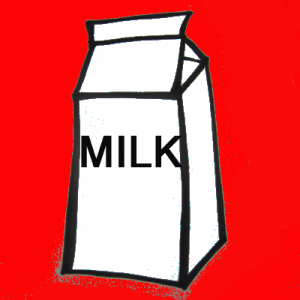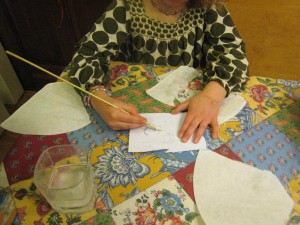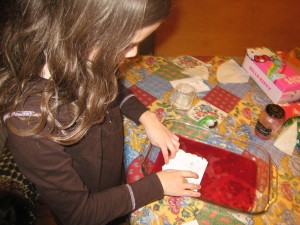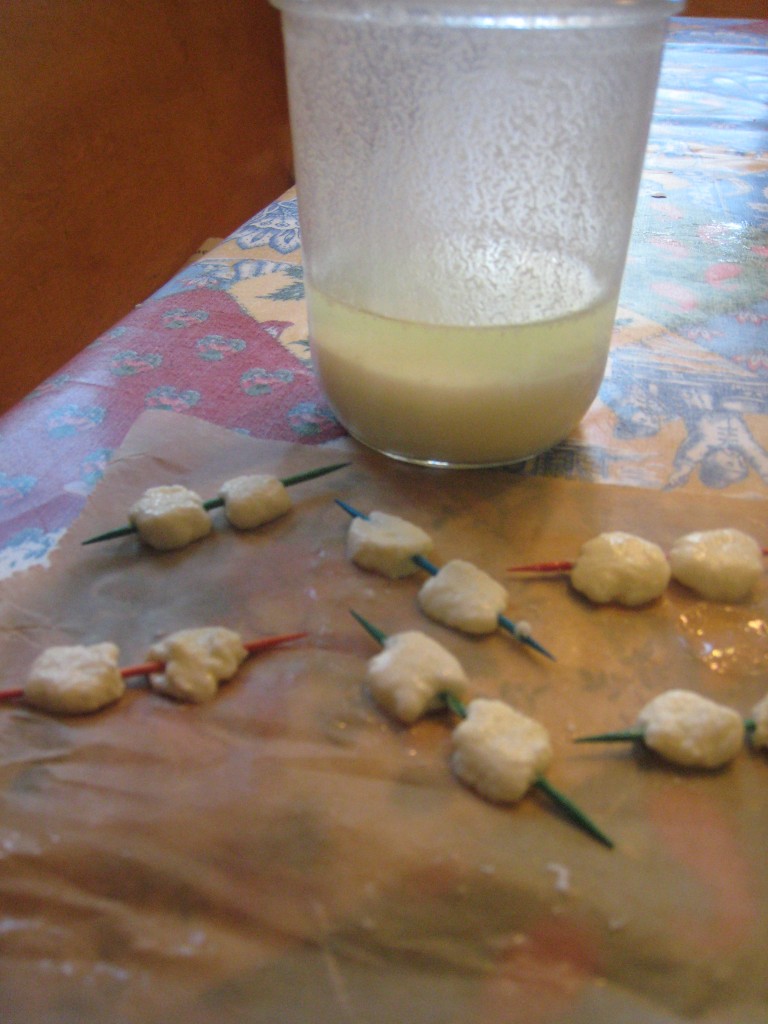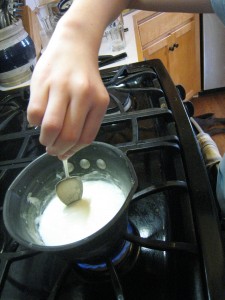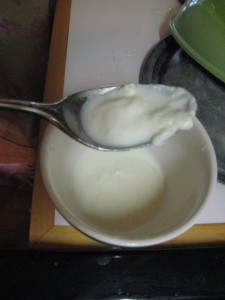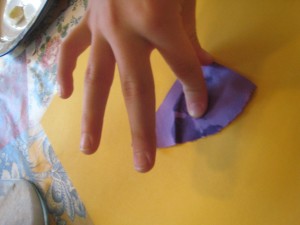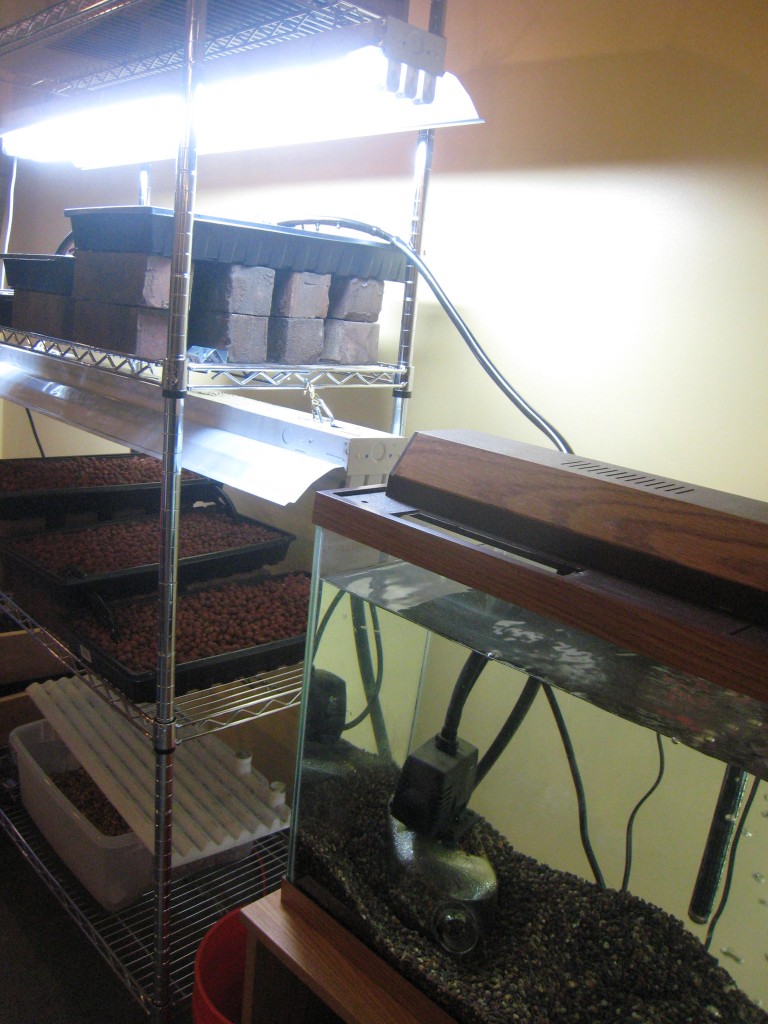Category:Food Science’
Ocean Acidification Experiment/ CO2 Breath Test
- by KitchenPantryScientist
Last week, I wrote about Carbon, Bananas, Coal and You and promised to try to come up with a safe, easy way to see the carbon dioxide in your breath, so here it is! (It’s one of the experiments featured in my book Kitchen Science Lab for Kids.)
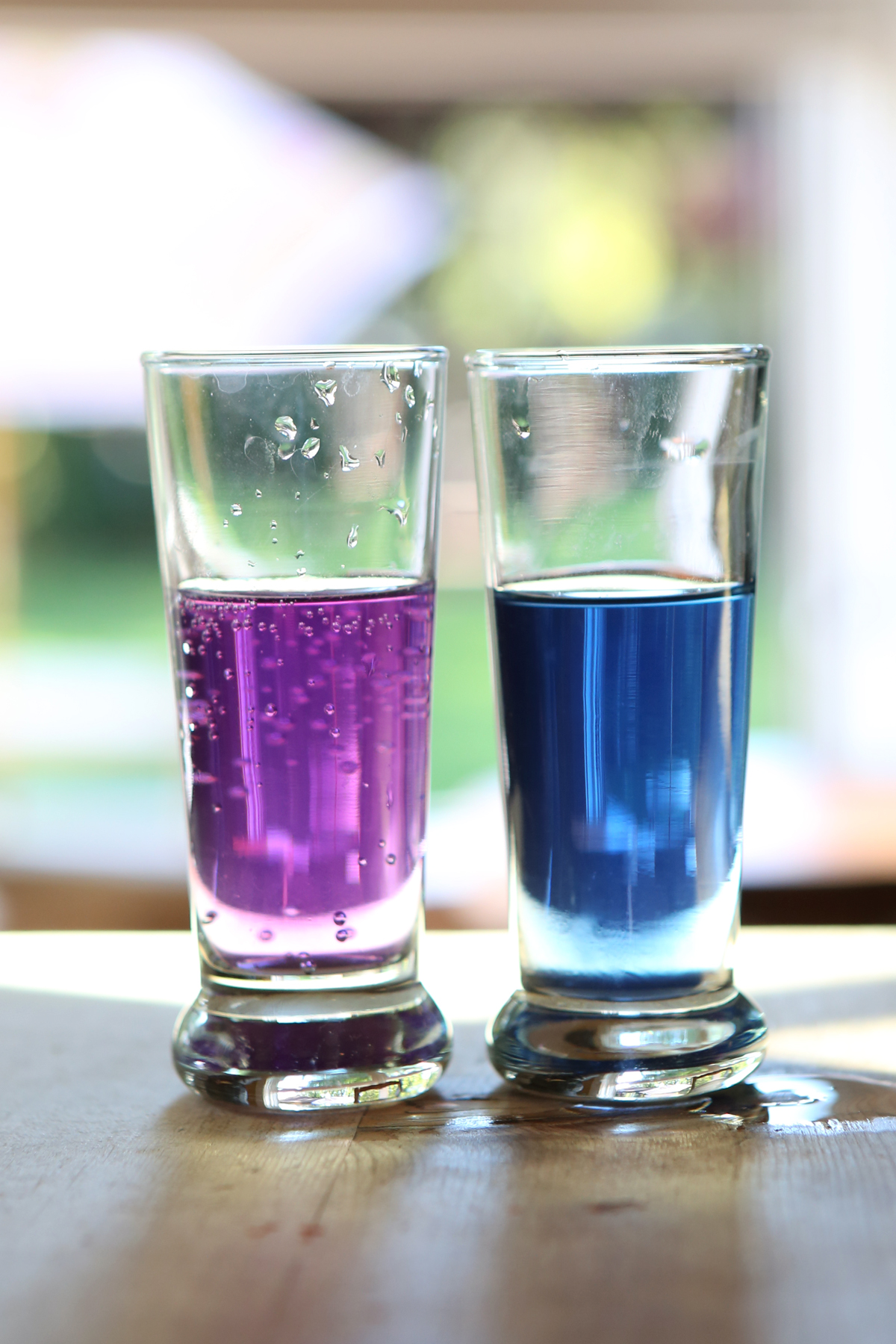
Ocean Acidification Experiment from Kitchen Science Lab for Kids (Quarry Books)
For both experiments, the star of the show is red cabbage juice, a safe, natural, easy-to-make acid/base indicator and the same one you can use to make magic potion and red cabbage litmus paper.
For the CO2 Breath Test, the trick is to use a very small volume of cabbage juice, since it’s not a very sensitive acid indicator.
You’ll need red cabbage, drinking straws, and very small cups (the ones you measure kids’ medicine with work well) or test tubes.
- Chop a head of red cabbage, boil it for 15 minutes, cool and collect the juice. It will be purplish in water and turns blue when exposed to a base or pink when exposed to an acid. (The molecule that gives it color can change shape to absorb light differently.)
- Pour a very small volume- a teaspoon or two (5 to 10 ml)- of the (cooled) juice into two small cups. Take a straw, put it all the way against the bottom of one cup and blow through the straw repeatedly for a few minutes until you see the cabbage juice turn noticeably pinker than the juice in the control cup. It may take several minutes to see a difference, so be patient! Test tubes are less messy since the juice can’t splatter so much.
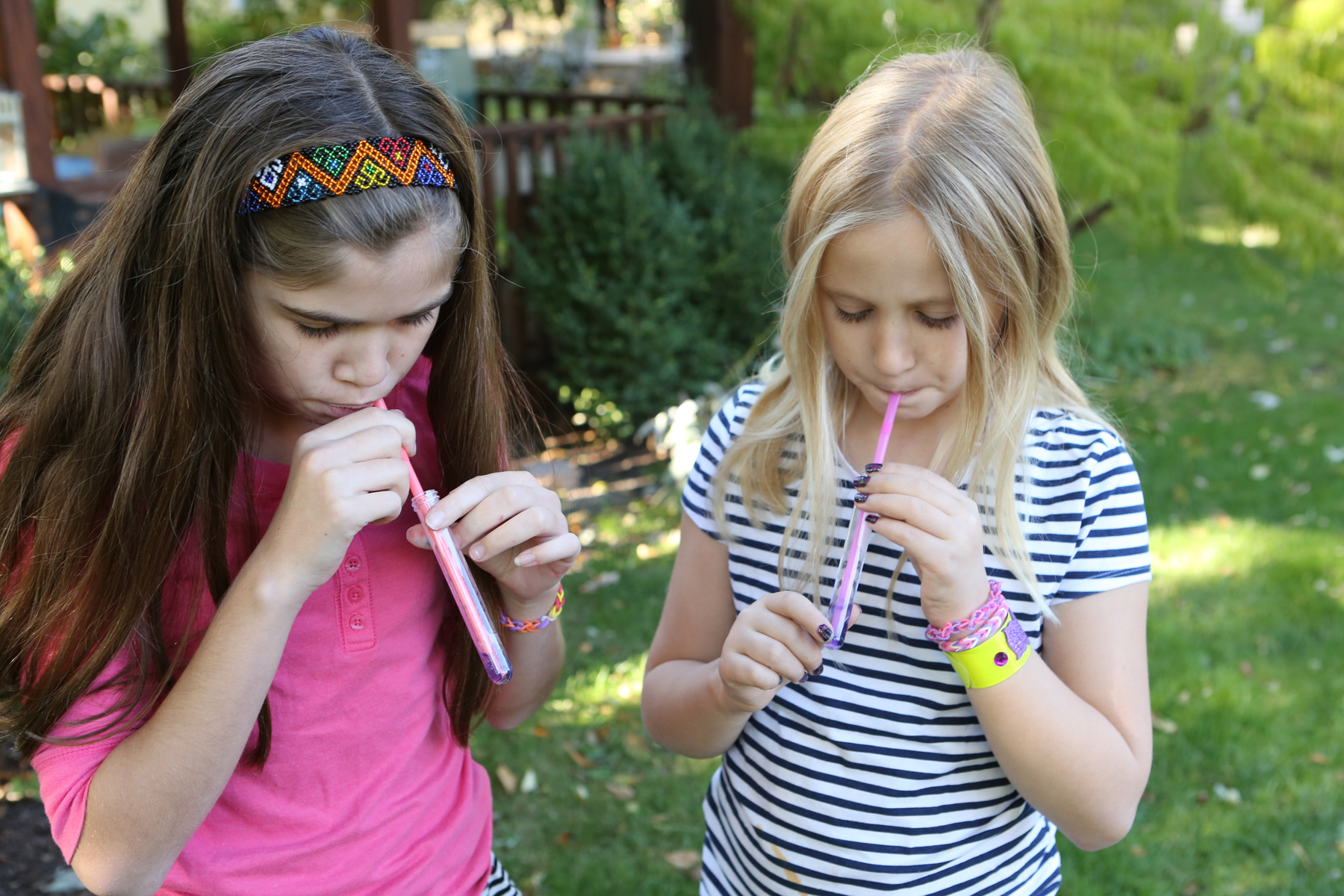
Ocean Acidification Experiment from Kitchen Science Lab for Kids (Quarry Books)
What happens? The carbon dioxide in your breath combines with the water in the cabbage juice to form carbonic acid, causing the pH of the solution to drop and the cabbage juice to take on a pinkish hue.
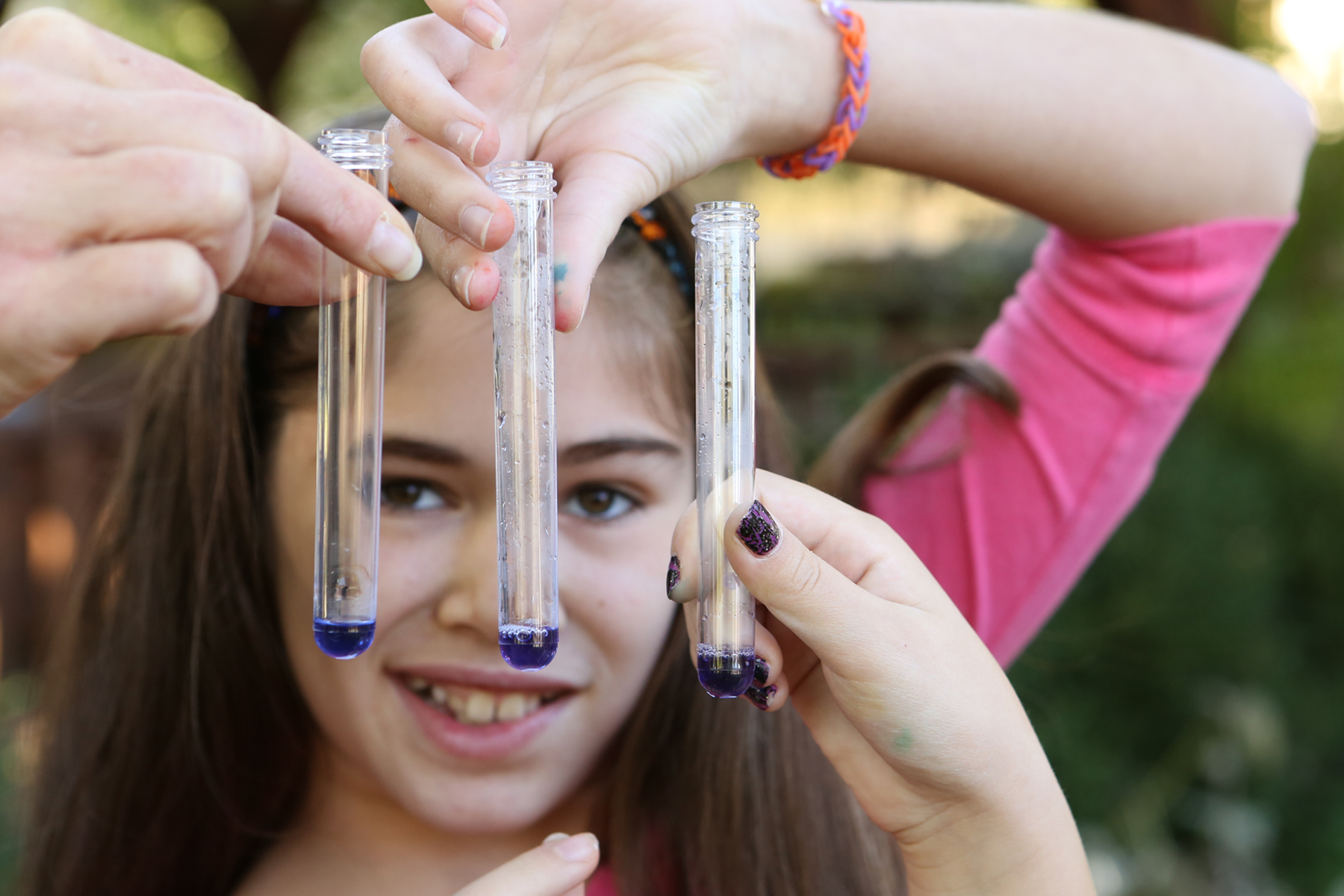
Ocean Acidification Experiment from Kitchen Science Lab for Kids (Quarry Books)
Why is this interesting? About a quarter of the carbon dioxide released by activities like burning fossil fuels and burning down rainforests is absorbed by our world’s oceans. This results in the ocean water becoming more acidic, like the cabbage juice in the experiment, and can have an effect on sea life, like coral. To learn more about ocean acidification and the chemistry of ocean acidification, check out NOAA’s amazing website.
You can explore the same concept (and see why carbonated drinks are hard on your teeth) by pouring uncarbonated water into one cup of cabbage juice and carbonated water into another. If you can, choose water from the same source, so you know the only difference is the carbon dioxide that’s been added to make it fizzy! Or, you could use dry ice to add carbon dioxide bubbles to water and test it before and after you add bubbles! 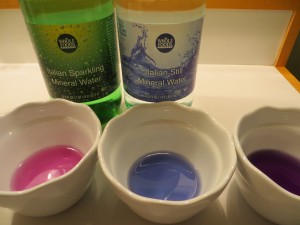
What happens if you add yeast to cabbage juice and let it grow for a while?
You can use your leftover cabbage juice to make red cabbage litmus paper and then for a “magic potion” experiment.
Food Science: Red Cabbage Litmus Paper
- by KitchenPantryScientist
This is a great science project and results in beautifully colored paper that can be dried and used for art projects like collages.

All you’ll need is a head of red cabbage and some paper towels or white coffee filters. Alternately, you can just use the juice from canned red cabbage. I’d recommend wearing an old tee shirt or a home-made lab coat for this project, since I’m guessing that cabbage juice stains. To make a lab coat, just have kids write their name in permanent marker on the pocket of an old button-down shirt.
Chop half a head of red cabbage into small pieces and add it to a pan with about a cup of water. Boil the cabbage uncovered for about 15 minutes, stirring occasionally, let it cool, and strain the juice into a jar or bowl. (Save the cooked cabbage for your favorite recipe and make cole slaw with the other half!)

If you want to avoid the stove, chop half a head of red cabbage and blend it with about 3 cups of water. Strain the liquid through a colander and then through a coffee filter in a plastic bag with one corner cut off. Blended cabbage juice makes longer-lasting bubbles and turns a slightly brighter shade of blue!
Cut the paper towels or coffee filters into strips about an inch wide and a few inches long and soak them in the cabbage juice for about a minute. Remove them and let them dry on something that won’t stain. I blotted them a little to speed up the drying process. You might even try using a blow dryer!
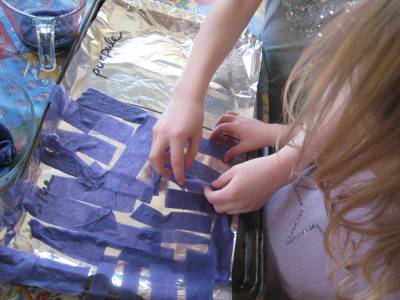
When dry, your litmus paper will be ready to use for testing acidity. Your can dip the paper into orange juice, soapy water, lemon juice, baking soda in water, baking powder in water, vinegar, and anything else they want to test. The paper will turn red-pink in acids and blue or green in bases.

Everything in our world is made of very tiny pieces called atoms. Atoms are so small that if you blow up a balloon, it will contain about a hundred billion billion atoms of the gases that make up air. Atoms are often bonded to other atoms to form a group of linked atoms called a molecule. A water molecule, for example, has two hydrogen atoms and one oxygen atom, bonded together.
Acids usually dissolve in water to form free-floating hydrogen atoms. Bases are the opposite and take up free hydrogen atoms. The molecules in the cabbage juice litmus paper change when exposed to an acid or base, making the paper change color.
How Safe is Your Milk?
- by KitchenPantryScientist
For years the F.D.A. has been threatening to do more rigorous testing of milk supplies for antibiotics. Now they’re going through with it, and many in the dairy industry are furious.
According to an article I read in the New York Times, inspectors have found both illegal levels of antibiotics, and types of antibiotics not regularly tested for, in older dairy cows that have been sent to slaughter. Anyone who doesn’t want their children getting an extra dose of drugs with their glass of milk should find this disturbing.
The fact that one large dairy COOP in the NorthEast told members to dump milk tested by the FDA in order to avoid recalls indicates that many in the industry are worried about what inspectors will find once they begin testing.
Large-scale agriculture is rife with antibiotics that are fed to beef cows to make them grow faster. What do consumers have to do to stop the overuse of these drugs in our food supply?
I plan to keep buying organic milk, hoping the tighter regulation and safer farming practices will keep my food pristine.
And please, test away, F.D.A. It’s your job to protect consumers. Don’t be afraid to do it.
Spy Juice and Invisible Ink
- by KitchenPantryScientist
Using cranberries and baking soda, you can create invisible messages that will be revealed to friendly eyes and self-destruct before your enemies have a chance to read them. You’ll see how some pigments in fruit can change color when they’re exposed to an acid or a base.
I showed viewers how to make Spy Juice on Kare11 this morning. Here’s the link, if you want to watch a video demonstration!
You will need half a bag of cranberries, water, baking soda and some printer paper. To write your message, you’ll also want to find a small paintbrush, Q-tip, or something else with an absorbent tip. We made our own pens by wrapping a tiny piece of paper towel around the pointed end of a wooden skewer and winding scotch tape around to secure it. Be sure to put on an apron or wear old clothes for this experiment, since cranberry juice stains!
Have an adult or teenager boil the cranberries in about three cups of water for 15 or 20 minutes. Be sure to put a lid on the pan, since the small pockets of air that help cranberries float can make them explode as they cook. If you listen, you’ll hear some of the them popping! Crush the cooked berries and push the liquid through a sieve or colander to collect the concentrated cranberry juice. Most cranberry juice from the grocery store is diluted with water, corn syrup and other juices and won’t work as well!
Let the juice cool and pour it into a casserole dish or cake pan that the paper you’re writing your messages on will fit into. If your cranberry juice seems thick and syrupy, add a little water (maybe half a cup.) It has to have enough water in it so that it will soak into the paper!
Add a few teaspoons of baking soda to about 1/3 cup of warm water and dissolve it as well as you can. (Don’t worry if you can still see some baking soda.) Using a Q-tip, paintbrush, or your homemade writing tool, use the baking soda solution to write a message on your paper. It may take a little practice, so don’t get frustrated. You’ll get the hang of it!
Let your message air dry, or speed things up with a blow dryer.
To reveal your message, place your paper in the cranberry juice and see what happens!
The science behind the fun:
Cranberries contain pigments called anthocyanins (an-tho-SY-a-nins), which give them their bright color. In nature, these pigments attract birds and other animals to fruit. This is important because animals eat the berries and spread plants seeds from one place to another.
These pigments, called flavanoids, change color when they come in contact with acids and bases. Cranberry juice is very acidic, and the pigment is red in acids. When you add it to a base, it turns purple or blue. Baking soda is a base, so your baking soda message will turn blue when it comes into contact with the pigments in the cranberry juice. Eventually, when enough cranberry juice soaks into the paper, it will dilute the baking soda and make the paper acidic, turning the pigment back to red and your message will disappear!
There are over 300 kinds of anthocyanins which are found in many fruits and vegetables including blueberries, red cabbage, grapes and blueberries. Scientists think they may have many health benefits and some researchers are even making organic solar cells using flavanoids!
What other juices can you use to reveal secret messages? What other bases could you use as ink?
Try making your own recipe for spy juice! I’d love to hear how red cabbage works! Check out my red cabbage litmus paper experiment to find out how to make red cabbage juice.
Let me know what works best!
Curds and Whey- Day 4 of Science Camp
- by KitchenPantryScientist
We discovered two easy experiments you can do with milk and vinegar. One is hot, and requires adult supervision, and the other is done at room temperature. Who knew you could make plastic and glue from milk?
Milk Plastic
The first experiment we tried was making “plastic” from milk curds. Heat about a cup of milk in a pan until it gets a scum on top or gets lumpy.
Skim off the scum (curds) with a spoon and put them into a small bowl to cool. Eventually, we got tired of skimming and just let a thick layer form on top of the liquid. Then, I poured the hot milk out of the pan and scraped out the curds with a spoon, adding them to the curds we’d already collected. Add a tsp. of vinegar and let the mixture cool for about an hour. Then, slowly pour off the liquid (we blotted some off with a paper towel too) and knead the “plastic”. You can shape your plastic into anything you want- beads, balls, animals and allow it to dry on a paper towel. When it’s dry, you can even paint it! Our plastic was very soft and gooey, so we rolled it into small balls on toothpicks to make beads.
Milk contains a protein called casein, which is a polymer, or a chain, or long molecules which can bend and move until the plastic hardens.
Homemade Glue
We also made glue using milk and vinegar. Just add a cup of milk and 1/3 cup white vinegar to a clear jar or bowl. Mix gently and allow the mixture to settle until you can see two layers. The curds are the white layer on the bottom of the jar and the whey is the liquid on top. Fish some of the curds out with a spoon or sieve, or just pour off the whey. The curds can be used as glue. We tried it and found that our homemade glue worked pretty well for gluing paper together!
The vinegar separates the milk, allowing the fat, minerals and casein protein to form curds. White glue is made from caseins of milk curds. Cheeses, as you probably already know, are made from curds.
I wonder how hard it is to make homemade edible cheese curds. Maybe that will be a project for another day.
Seafood Watch
- by KitchenPantryScientist

Eat fish. It’s good for you .
We hear this message over and over, and it’s true. Fish is good for you.
Most people are also aware that eating to much fish can be bad for you too, if it’s the kind of fish that tend to build up heavy metals and pesticides. Farm-raised fish can be full of toxins, depending on how they’re raised. After all, you are what you eat, even if you’re a fish.
Sadly, our appetite for our finny ocean friends has brought many of our favorite fish to the brink of extinction. The majestic Bluefin tuna is almost certainly doomed and many other species are in trouble too. It may not seem like a big deal, but fragile ecosystems hang in the balance.
What can you do to help save our oceans? Visit the Monterey Bay Aquarium’s Seafood Watch website and print off a Seafood Watch Pocket Guide to help you select seafood that is both safe to eat and abundant enough to be well-managed and caught in environmentally-friendly ways. They even have a sushi guide.
If you want to shop at a grocery store that sells seafood responsibly, Whole Foods Market seafood department works harder than any other fish market (I know of) to help keep farmed seafood and the environment healthy. They use the Seafood Watch program for wild-caught seafood and buy the rest from Marine Stewardship Council Certified Fisheries. I love their seafood department and I can enjoy their sushi without guilt!
In other words, if you do your homework, you can feel even better about eating fish!
The Monterey Bay is one of my favorite places in the world, and the Monterey Bay Aquarium is an amazing resource teeming with ocean life. Click here to go to webcams at the aquarium where you can watch fish, sharks, jellyfish, otters and more!
Beneficial Bacteria: Our Best Defenders?
- by KitchenPantryScientist
Did you know that we have ten times more microbes in our bodies than human cells? It may sound gross, but these microbes are often more friend than foe and keep us healthy in return for a little space to call their own.
There was a fantastic article in yesterday’s Science Times about microbiomes- what scientists call the collection of microorganisms colonizing our bodies. The study of microbiomes has intensified in recent years and scientists are trying to catalog some of the bacteria we carry.
I eat yogurt filled with healthy, or beneficial, bacteria on a daily basis to keep a healthy population of these little helpers living in my gut. This keeps the bad bacteria from finding a place to take hold. A more extreme version of this was mentioned in the Science Times article, where a woman dying of an intestinal infection caused by pathogenic, or bad bacteria was saved when bacteria from her husband’s intestines was introduced into her large intestine. Within hours, the good bacteria had “kicked” the bad bacteria out, taking over residence.
I also learned that babies born by C-section (like my three kids) are more prone to skin infections and asthma, possibly due to the fact that coming from the sterile amniotic sac, they are colonized by bacteria from adults’ skin rather than that bacteria from their mother’s birth canal. In fact, people with asthma have a different set of lung microbes than healthy people and obese people have a different set of bacteria in their guts than people of normal weight.
You’ve heard that kids on farms and are exposed to dirt have healthier immune systems than city kids? It’s not the dirt itself, but the microbes in the dirt giving them their immune systems a boost.
There are years of hard work in the lab ahead of scientists to validate their beliefs that beneficial bacteria may one day be a weapon in the arsenal against infectious disease, but in the meantime, I plan to keep eating my yogurt and letting my kids play in the dirt.
Clean Water, Clean Fish, Green Plants
- by KitchenPantryScientist
I don’t usually buy farm-raised fish. Too many articles I’ve read tell me that the fish are polluted with chemicals and that fish-farming pollutes the environment. So, I dutifully check my Seafood Watch card and spend a little more on wild, sustainable, healthy fish.
When our Twin Cities blogging group, the Blog Pantry, met at Local D’Lish a few weeks ago, my eyes were instantly drawn to a fish tank set up at the back of the grocery store. The owner, Ann, told me they were setting up a small-scale aquaponics system that would use water from the fish tank to fertilize vegetables and herbs they were planning to grow in the store. I had seen a larger-scale version of the same thing on Will Allen‘s amazing 3-acre urban farm in the middle of downtown Milwaukee in the film “FRESH.”
Apparently, this type of closed loop, recycling system allows people to grow crops using less water while raising cleaner fish for food. Systems like these may revolutionize the way people farm in the future.
According to an article in the Christian Science Monitor,
“Recirculating aquaculture systems, or RAS, are closed-loop production systems that continuously filter and recycle water, enabling large-scale fish farming that requires a small amount of water and releases little or no pollution.
About 99.75 percent of the water in each unit is continuously cleaned and returned to the fish tanks. Manure filtered from the water during the recycling process is used as fertilizer on nearby farm fields. The nutrient-rich water can also be used to feed vegetables and herbs in large-scale aquaponics systems, which in turn filter the water for reuse.
One of RAS’s biggest benefits is its small “water footprint,” which opens the door to commercial fish production in areas with limited water resources. (The technology is proven for both fresh- and saltwater systems.)
Cool! Maybe someday, we’ll all have little kitchen gardens hooked up to fish tanks!
In the meantime, I look forward to a future where I can buy farm-raised fish with a clean conscience.
Raw Milk isn’t Worth the Risk
- by KitchenPantryScientist
In today’s paper, I was disgusted to read that two school-age children, a toddler and a 70-year old man were victims of an E.coli outbreak this week caused by raw milk from a Minnesota dairy. The toddler is currently hospitalized with a serious condition related to the infection (hemolytic uremic syndrome) which can cause kidney failure and death. These are unnecessary illnesses and people are putting themselves and their children at risk by drinking raw milk.
Pasteurization is the process of heating up food to kill any bacteria it might contain. Louis Pasteur first tested the process in 1864 and it is perfectly safe. However, some people who drink raw milk feel that beneficial proteins and bacteria are destroyed during the heating process.
According to the Health Department, several dozen people are sickened by raw milk every year in Minnesota. Unpasteurized milk can contain the live pathogens, or bad bacteria, E. coli, Salmonella and Campylobacter. Most people are careful handling and cooking meat to avoid the very same pathogens. Why they wouldn’t mind drinking them is a mystery to me.
Beneficial, or “good” bacteria can be found in most yogurt and many companies now add beneficial bacteria to other dairy items, including pasteurized milk. I suspect that many of milk’s other beneficial heat-sensitive proteins can be found in other, safe foods as well. Even raw milk cheese made correctly is safer than raw milk, because it contains other microbes that inhibit the growth of pathogens.
Maybe people don’t realize it, but giving their child a glass of raw milk is as risky as feeding them a raw hamburger. I’m glad to hear the state is cracking down.
“Food Rules” I Can Live By
- by KitchenPantryScientist
This afternoon, I buzzed through Michael Pollan’s “Food Rules”, which are basically his Cliff Notes on a healthy diet. His mantra is “Eat food. Not too much. Mostly Plants,” which is hard to argue with when you look at the superior health of nations who eat according to those rules. Here in America, where we eat mostly highly processed, sweetened and fatty foods, we’re on the verge of a national epidemic. Obesity and diabetes will kill more and more people each year, young and old alike, and further cripple our ailing health care system if we don’t change our eating habits. Americans literally can’t afford to keep eating this way.
Here are some of my favorite food rules from the book:
#13 “Eat only foods that will eventually rot.” It is scary that there are foods that even bacteria and fungi won’t touch.
#19 “If it came from a plant, eat it. If it was made in a plant, don’t.” I can follow this maybe 70% of the time, but I love cold cereal.
#27 “Eat animals that have themselves eaten well.” Costs a little more, but who wants mad cow disease?
#36 “Don’t eat breakfast cereals that change the color of milk.” My kids and husband love Fruity Pebbles, but I ALMOST never buy them.
#37 “The whiter the bread, the sooner you’ll be dead.” Complex carbs rule.
#41 “Eat more like the French. Or the Japanese. Or the Italians. Or the Greeks.” How do you say “yum” in all those languages?
#43″ Have a glass of wine with dinner.” My favorite food rule.
#44 “Pay more, eat less.” Why are people willing to spend money on everything EXCEPT healthy food?
#58 “Do all your eating at a table.” This is harder than it sounds, but a great rule and teaches your kids good eating habits.
#59 “Try not to eat alone.” Eating is most enjoyable when it’s a shared activity.
#63 “Cook.” We only order pizza once a week. That’s not so bad, is it?
#64 “Break the rules once in a while.” My second favorite rule and essential to the sanity of anyone with kids to feed.
So, this weekend, call some friends, cook a good meal (that includes a salad) and open a bottle of wine. You’ll just be following the rules.
Posted on “Food Renegade’s” Fight Back Friday July 1, 2010
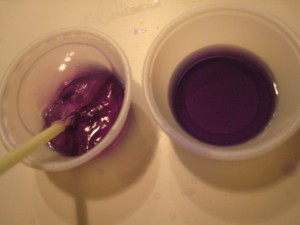 or
or 